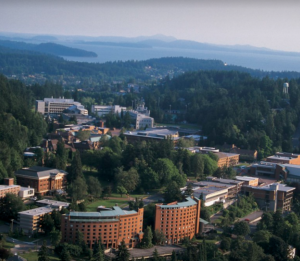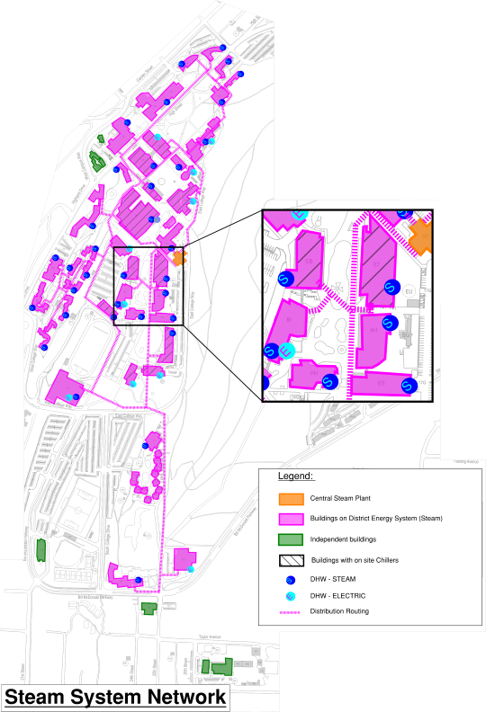Transforming Campus Energy: Decarbonization at Western Washington University
February 2025
As engineers and sustainability advocates, we thrive on solving these complex energy challenges. Seeing Western take concrete steps toward a cleaner, more efficient future is incredibly rewarding, and we’re excited to continue playing a role in their journey toward carbon neutrality.
By Tom Marseille, PE, LEED Fellow
.
Last week, some industry colleagues and I had the opportunity to present at CampusEnergy2025 in Boston. This annual event, hosted by the International District Energy Association (IDEA), continues to grow in prominence, reflecting the increasing attention on district energy solutions. With more than 1,300 attendees this year, it’s clear that the drive for decarbonization on college campuses is a major priority. This is especially true in Washington State, and the attendees from our region reflected that.
Our presentation, Moving Parts and Partners: Challenges and Opportunities in a Campus Central Heating System Conversion, focused on Western Washington University (Western)’s transition from an 80-year-old campus steam heating system to a modern district energy solution. The project is an ambitious step toward achieving Western’s carbon neutrality goals while addressing aging infrastructure, rising operational costs, and the need to add cooling to existing academic buildings. Here’s a look at what we discussed.
The Case for Change: Why Decarbonize?
Western Washington University, a 215-acre campus in Bellingham with approximately 16,000 students, currently relies on a central steam system powered by gas-fired boilers. This system serves 54 buildings and accounts for 86% of the university’s Scope 1 and Scope 2 greenhouse gas (GHG) emissions. It was estimated that more than 30% of the heat generated is lost in distribution, making the steam system both inefficient and costly to maintain.
The university’s motivation to decarbonize aligns with several key factors:
- Sustainability Goals: Western has committed to achieving carbon neutrality by 2035, as outlined in its Sustainability Action Plan.
- State Mandates: Washington’s Climate Commitment Act and House Bills 1257 and 1390 are pushing public institutions toward cleaner energy solutions.
- Aging Infrastructure: The steam boilers are well past their service life, making maintenance expensive and replacement parts difficult to find.
- Staffing Challenges: Skilled steam plant operators are becoming increasingly scarce.
- Rising Cooling Demands: As campus operations extend further into summer and wildfires become more frequent, the need for cooling solutions has become more pressing.
A Phased Approach to Electrification
Our team began addressing this challenge in 2022 with a feasibility study. The preferred approach that came out of the study was to transition Western from a centralized steam system for the campus to a low-temperature hydronic heating and chilled water system using four decentralized “nodal” energy plants. These plants would be powered primarily by a combination of air-source and ground-source heat pumps, providing a sustainable and flexible energy solution.
Key elements of the preferred alternative include:
- Replacing steam distribution with hot water and chilled water piping to improve efficiency and reduce energy losses.
- Utilize heat pumps and heat recovery chillers to provide both heating and cooling.
- Phasing implementation over time to minimize disruption to campus operations.
Based on the 2022 feasibility study, Western was able to procure $10 million in initial funding from the State. Using a portion of this funding, Western hired an Owner Advisory team with Säzän Group as the Technical Lead. The Owner Advisory team worked in 2024 to refine the concept further, validating the anticipated scope, schedule, and construction budget. Western is now pursuing a progressive design-build delivery model and has submitted a capital budget request for the 2025–2026 biennium.
Overcoming Technical Challenges
Implementing this transformation on a working campus presents numerous challenges. Among these are:
- Phased Construction on an Active Campus: Coordinating with other planned projects to minimize disruption is crucial.
- Building Conversions: Most campus buildings were designed to use steam as an energy source via a steam converter to generate heating water at 180F and domestic hot water. Upgrades are required in each to enable the effective use of low-temperature heating water that can be readily served by the nodal heat pump plants.
- Adding Cooling Capacity: Most of the buildings on campus were not originally designed for cooling, making the integration of chilled water systems a complex process.
Leading the Way in Campus Decarbonization
Western’s commitment to decarbonization is setting a precedent for other institutions. With a carefully phased approach, alignment with sustainability goals, and a progressive design-build model, this project is well-positioned to become a blueprint for campus energy transitions in Washington State and beyond.
As engineers and sustainability advocates, we thrive on solving these complex energy challenges. Seeing Western take concrete steps toward a cleaner and more efficient future is incredibly rewarding, and we’re excited to continue playing a role in their journey toward carbon neutrality.
Team:
Introba
OAC Services
Säzän Group
Western Washington University


